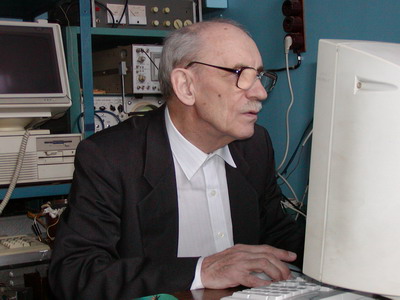Ponomarev Boris Konstantinovich
 |
Position: Leading research scientist.
Address: Institute of solid state physics,
RAS,
142432, Chernogolovka, Moscow district, Russia.
Location: 121 ETK.
Fax: 7-096-524-9701 (from abroad).
8-2-524-9701 (from Moscow and Moscow district).
8-096-524-9701 (from other Russia regions and former USSR countries).
e-mail: ponom@issp.ac.ru |
Research interest:
1.Magnetic and magneto-elastic properties of heavy rare earth
metals.
In the sixties years of the last century the great interest was attracted
to the rare earth metals and their compounds. It was due to their unusual magnetic
properties – very large paramagnetic susceptibility and extremely high magnetic
anisotropy. Usual magnetic equipment of that period with the magnetic fields
of ~50 kOe was not enough for the investigations of those metals. High magnetic
fields of 100 kOe and more were necessary to saturate the magnetization of
havy rare earth metals.
B. K. Ponomarev worked out the original experimental equipment to measure
the magnetization, the magnetic anisotropy constants and the magnetostriction
in pulsed magnetic fields up to 150 kOe at the temperature range (78 – 350)K.
B. K. Ponomarev was the first investigator who measured the torque in the pulsed
magnetic field.
The magnetization, the magnetic anisotropy and the magnetostriction of the
single crystal samples of Gd, Tb, Dy, Ho and Er metals were investigated. The
effect of the elongation of the spontaneous magnetic moment of the crystal
due to its rotation from the easy magnetic direction to the heavy one was observed.
The magnetic anisotropy constants were measured. The peculiarities of the magnetic
properties of heavy rare earth metals were explained by the existence of the
nonzero angular moment in rare earth ions. It was shown that the effective
exchange field theory is sufficient for the description of the magnetic order
in heavy rare earth metals and their compounds.
2. The duality of the state of the magnetic carriers in the traditional
3d-magnetic materials. The applicability of the theory of the effective
field .
The peculiarity of the way of the development of the magnetic science was
in that the first ferromagnetic materials – iron, cobalt, nickel and so on
- were essentially collective systems and the first theory of the magnetic
order – the Weiss molecular field theory - was developed for essentially individual
magnetic carriers.
Naturally this theory was very far from the real behavior of 3d-ferromagnetics
known at that time. Due to this disagreement very many researchers did not
accept the effective field approximation as the satisfactory tool for the description
of the ferromagnetism.
Many researchers noted, that the carriers of the magnetic moments in 3d-ferromagnetics
should be itinerant. But the neutron experiments showed that the carriers of
the magnetic moments in nickel were evidently localized near their atoms. This
was the origin of the hypothesis of the dual nature of the magnetic moments
in 3d-ferromagnetics.
B. K. Ponomarev saw the quite satisfactory agreement of this theory with the
experimental results for heavy rare earths. He paid attention on the theory
of the magnetic order that was developed by Stoner and Wohlfarth on the base
of the effective field approximation for the magnetic carriers with the Fermi
statistic.
He worked out the experimental equipment for magnetic measurements in pulsed
fields up to 400kOe at temperatures up to 700K (in the collaboration with V.
G. Tissen). The measurements of the magnetization of nickel in high fields
and at high temperatures showed that the effective field theory with the Fermi
statistic describes the magnetic properties of nickel quite satisfactory. So
it was shown that the effective field theory is a very good tool if one uses
the right statistic.
This experiment solved also the problem of the duality of the state of the
magnetic carriers in the 3d-metals. The explanation was that the main thing
is not the spatial localization or delocalization but the width of the energy
band of the carriers. The band can be wide enough comparatively to the exchange
interaction to apply the band theory and all the same the spatial localization
can be strong enough to produce the distinctive maximum on the neutron pattern.
These investigations stimulated the development of the approach of the rigid
band theory for the description of the magnetic properties of the hydrides
of the 3d-metals obtained in the laboratory of the physics of high pressure.
3.Magneto-electric interactions.
B. K. Ponomarev discovered the nonlinear magneto-electric effect in paramagnetic
ferroelectric rare earth molybdates family (in collaboration with B. S. Red'kin,
C. A. Ivanov and V. N. Kurlov). These are the first group of substances in
which the spontaneous electric polarization can be reversed using only the
magnetic field without applying the electric field.
He observed the intensive green photoluminescence in terbium molybdate under
the blue laser irradiation (in the collaboration with V. D. Negrii). It was
accompanied by the appearing of large photo-voltage (about 30 Volts).
He observed two types of the photo-induced electric voltage in rare earth
molybdates – due to exciting of rare earth ions and due to ionizing them.
4.The ferro-electric domain contrast under the electron irradiation.
He observed the spontaneous reversal of the ferroelectric domain contrast
induced in terbium molybdate by the electron beam in the electron microscope
(in the collaboration with L. S. Kokhanchik) and derived the theory of the
double electric layer explaining the effect.
5.Spontaneous currents in rare earth molybdates under the high
pressure.
B. K. Ponomarev showed experimentally that the high hydrostatic pressure (about
20 kilobars) induces in rare earth molybdates the redistribution of the charge
density that should be taken into account while identifying the phase transition.
|


